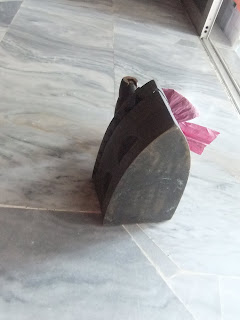Dear friends,
Today, I spotted my charcoal iron which has been
displayed at one of the dining corner for many years. This iron has served my family for more than two decades before my mother retired it and kept it for many years before she passed it to me for custody and safekeeping.
Here, I rather let the photos do the talking.
Notice the hinged lid and the air holes to allow the charcoal to keep smoldering. These are sometimes called ironing boxes, or charcoal box irons, and may come with their own stand. However, in my case I only have the iron box and searching for its own stand (the iron ring and a piece of flat square hard wood).
It is very much heavier compared to the electric
iron. To add more colour to this article. we also extracted the history of ironing and some information on box and charcoal iron for your reading pleasure. No-one can say exactly when people started trying to press cloth smoothly, but we know that the Chinese were using hot metal for ironing before anyone else. Pans filled with hot coals were pressed over stretched cloth as illustrated in the drawing to the right. A thousand years ago this method was already well-established.
Meanwhile people in Northern Europe
were using stones, glass and wood for smoothing. These continued to be use for "ironing" in some places into the mid-19th century, long after Western blacksmiths started to forge smoothing irons in the late Middle Ages.
Box irons, charcoal irons
If you make the base of your iron into a
container you can put glowing coals inside it and keep it hot a bit longer. This is a charcoal iron, and the photograph (right) shows one being used in India, where it's not unusual to have your ironing done by a "press wallah" at a stall with a brazier nearby. Notice the hinged lid and the air holes to allow the charcoal to keep smouldering. These are sometimes called ironing boxes, or charcoal box irons, and may come with their own stand. For centuries charcoal irons have been used in many different countries. When they have a funnel to keep smoky smells away from the cloth, they may be called chimney irons. Antique charcoal irons are attractive to many collectors, while modern charcoal irons manufactured in Asia are also used in much of Africa. Some of these are sold to Westerners as reproductions or replica "antiques".
Some irons had shallower boxes and had fitted
"slugs" or "heaters" - slabs of metal - which were heated in the fire and inserted into the base instead of charcoal. It was easier to keep the ironing surface spotlessly clean, away from the fuel, than with flatirons or charcoal irons. Brick inserts could be used for a longer-lasting, less intense heat. These are generally called box irons, although they used to be known as ironing boxes too.
Late 19th century iron designs experimented with
heat-retaining fillings. Designs of this period became more and more ingenious and complicated, with reversible bases, gas jets and other innovations. See some inventive US models here. By 1900 there were electric irons in use on both sides of the Atlantic.
Hope you find the above discussion of assistance
to you. We are look forward to seeing you again. TO READ OTHER RELATED ARTICLE, PLEASE CLICK THE LINK BELOW:-
Your Chief Servant,
James Oh
Founder and Group CEO
Skype me at james.oh18
|
Pages
- Home
- JAMES OH
- TEA ART BLOG
- Money Tells Stories
- Christian Walk Toward Destinty
- Stay Healthy Through Jokes
- TO EMPOWER YOUR BEAUTY AND WEALTH
- COLLABORATORS
- LIFT YOU UP MANDARIN
- PROFILE OF AUTHOR
- GUIDELINES FOR GUEST POST
- LIFT YOU UP COMMUNITY
- ABOUT JAMES OH - DRIVING SUSTAINABLE VALUE CREATION
- BETTER THAN THE BEST BY JAMES OH
- 2B INTERVIEWED BY US
PURPOSE OF THE BLOG
Followers
Search This Blog
Translate
Monday, June 7, 2010
IRON - CONVENTIONAL AND CHARCOAL TYPE
Labels:
MONEY
Subscribe to:
Post Comments (Atom)











No comments:
Post a Comment